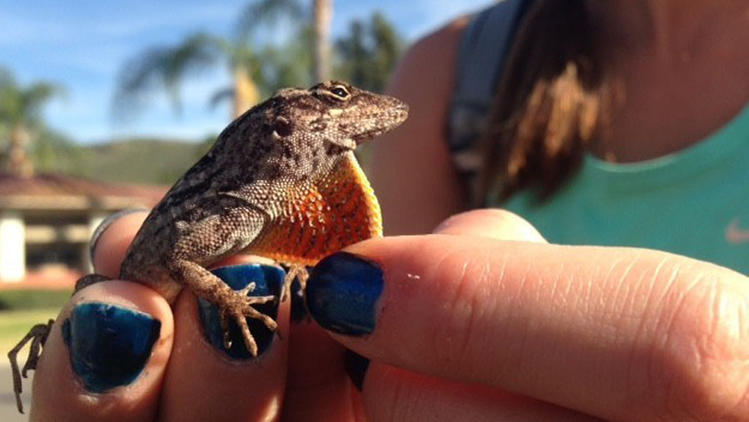Louis Shanghan of the LA Times reports on Greg Pauly‘s field surveys of non-native Cuban brown anoles (Anolis sagrei) and geckos in Orange County neighborhoods

“The anoles, which are native to Cuba, arrived here about a decade ago as stowaways in nursery plants,” Pauly said as the team strode down a leafy street, methodically scanning sidewalks, brick walls and tree trunks for the stick-like shapes of lizards basking in the sun. “Today, there’s at least 10 to 20 per residential lot in this neighborhood alone.”
“There’s a nice one over there,” he said, nodding toward an anole – about five inches long, adorned with light brown speckles and a bright line running from head to tail – clinging to the side of a front-yard planter box.
Full story here: Scientists survey an Orange County neighborhood’s nonnative lizard populations
As a side note, the details for the original record (as far as I know) of A. sagrei in California are as follows:
The first published documentation was in Herpetological Review 45(4), 2014, an edited version of which you can read below:
ANOLIS SAGREI (Cuban Brown Anole). USA: CALIFORNIA: San Diego Co.: Vista, elev. 158 m) 19 July 2014.
C. Mahrdt, E. Ervin, and L. Geiger. Verified by Bradford D. Hollingsworth. San Diego Natural History Museum (SDSNH 76128–76133).
New county and state record (Granatosky and Krysko 2013. IRCF Rept. Amphib. 20[4]:190–191)
Four adult males and two hatchling specimens were collected on a one-acre parcel landscaped with palms, cycads, and several species of tropical plants and ground cover. Several boulders scattered throughout the parcel were used as perch sites for male lizards. An additional 16 adults and six hatchlings were observed in the two-hour site visit (1030–1230 h). Adults were also observed beyond the property indicating that this population is established and likely expanding through the contiguous tropical landscaping of neighboring properties. According to the property owner, he first observed the species in August 2012 shortly after receiving shipments of palm trees in May–August originating from suppliers located in the Hawaiian Islands.
CLARK R. MAHRDT, Department of Herpetology, San Diego Natural History Museum, San Diego, California 92102, USA (e-mail: leopardlizard@ cox.net);
EDWARD L. ERVIN, Merkel & Associates, Inc., 5434 Ruffin Road, San Diego, California 92123, USA;
GARY NAFIS, (www.californiaherps.com).
More information on A. sagrei in California can be found here




 I’m always amazed by the ability of anoles to survive–even prosper!–with dramatic injuries. How could a lizard get by missing half of a hind leg? How does it capture prey or escape predators? Display credibly? But they do.
I’m always amazed by the ability of anoles to survive–even prosper!–with dramatic injuries. How could a lizard get by missing half of a hind leg? How does it capture prey or escape predators? Display credibly? But they do. 







![IMG_5612[1]](https://i0.wp.com/farm2.staticflickr.com/1603/24973410511_c2eee8971f_c.jpg?resize=629%2C420&ssl=1)
![IMG_5611[1]](https://i0.wp.com/farm2.staticflickr.com/1624/24699126379_d365d22614_c.jpg?resize=629%2C420&ssl=1)
![IMG_5610[1]](https://i0.wp.com/farm2.staticflickr.com/1445/24771217750_52b54cb15e_c.jpg?resize=629%2C420&ssl=1)
![IMG_5608[1]](https://i0.wp.com/farm2.staticflickr.com/1684/25040596346_7995af2423_c.jpg?resize=629%2C420&ssl=1)
![IMG_5607[1]](https://i0.wp.com/farm2.staticflickr.com/1663/25039699926_3d94c0c11d_c.jpg?resize=629%2C420&ssl=1)
![IMG_5626[1]](https://i0.wp.com/farm2.staticflickr.com/1441/25039756456_14f5237702_c.jpg?resize=629%2C420&ssl=1)
![IMG_5616[1]](https://i0.wp.com/farm2.staticflickr.com/1595/24698893089_fb7259ab28_c.jpg?resize=629%2C420&ssl=1)
